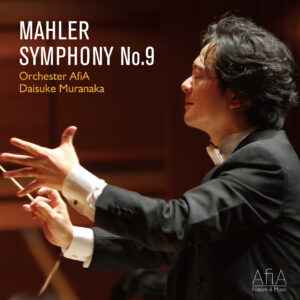Recent Updates!
Next Concert
2nd October, 2026 Yokohama Minato Mirai Hall
Daisuke Muranaka & Orchester AfiA Nature & Music Concert Series Vol.14 “Die Wunde und Heilung”
Latest Issue from AfiA LLC.
AfiA Label relauched their 4th album!
Mahler Symphony No.9
Daisuke Muranaka conductor
Orchester AfiA
31, March, 2023 @ Yokohama MINATO MIRAI Hall Live Recording
Mahler Symphony No.9 4th Mov.
Mahler Symphony No.9 2nd Mov.
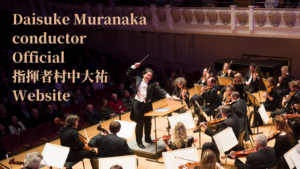
Daisuke Muranaka conductor
Artsitic Director & Founder Orchester AfiA
International Guest Conductor English Chamber Orchestra
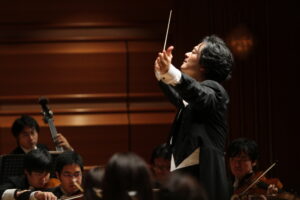
“Muranaka drove the music forcefully forward while retaining sprightly buoyancy, and summoned an appropriately heroic spirit…” (Claire Seymour)
In 2013 Daisuke Muranaka was appointed as an Artistic Director and Principal Conductor of newly formed Symphony Orchestra in Tokyo, “Orchestra AfiA”, with which he has embarked upon the series of concerts entitled “Nature and Music” in Tokyo , with recording plans which includes Mendelssohn , Schumann, Schubert and the Beethoven Cycles. Recently he made a Japanese Premiere of the new chamber orchestra version of Mahler’s “Das Lied von der Erde” with Orchestra AfiA and had a great critical approval in his country.
His recent featured concerts on the “Nature and Music” programme got a attention from all over the world, and became one of the nominee from over 2000 music institutions for the “Innovation Award” 2016 in Classical:NEXT.
Mr. Muranaka ’s glittering career as a conductor first came into prominence in 1996, when he made his operatic debut in Italy with “ Die Zauberflöte “ in Treviso Teatro Mario Del Monaco at two hours notice because of the sudden illness of Peter Maag, with whom he had a long musical partnership as an assistant of Peter Maag’s last years. His current worldwide Opera performances include La Grand Teatro La Fenice di Venezia , Teatro Massimo di Palermo, Glyndebourne Festival Opera, Theater St. Gallen, Teatro Comunale di Treviso “Mario del Monaco”, The National Theater in Tokyo and many others. Among which, in Teatro Massimo di Palermo, Mr. Muranaka ‘s interpretation of “Manon Lescaut” had a biggest acclaim after the newly reopened Scilian Theater with Norma Fantini in title role and Gazzettino di Treviso says “ Puccini must be conducted like this..”.
Performances have taken him to many concert Venues such as Verdi Hall (Milan), Palais des Beaux-Arts(Brussels), Cadogan Hall (London), Ueno Bunkakaikan(Tokyo) , Teatro Massimo , Teatro Politeama (Palermo), Grand Teatro Fenice(Venezia) and many others.
He has also conducted many Italian and Japanese premières for contemporary composers such as F. Pennisi and H.W.Henze, gaining the composer’s own praise for his interpretation.
His next European appearance will be in Malmesbury with the English Chamber Orchestra in May conducting Beethoven’2nd Symphony, and will be back to Tokyo to continue his 2016~17 Season with his Orchestra AfiA , including Mendelssohn Cycles.
Mr. Muranaka has enjoyed success as a conductor in Japan after winning prestigious “ Idemitsu Music Award 2001” and already conducted almost all Japanese Orchestras such as NHK Symphony, Tokyo Philharmonic, Yomiuri Symphony, Kyoto Symphony, Nippon Century Orchestra, New Japan Symphony, Japan Symphony, Kyushu Symphony, Gunma Symphony, Tokyo City Pilharmonic and Tokyo New City Orchesta.
His discography includes a recording of Rachmaninov’s 3rd Piano Concerto with Paquale Ianonne (Phoenix) and Mendelssohn’ Scottish Symphony with the Orchestra AfiA(WAKA) that has been released released with great critical acclaim in Japan, recognized as one of the reference CDs in 2015.
Daisuke Muranaka’s last performance with the English Chamber Orchestra was the Schubert Tragic Symphony in Gloucestershire and the Mendelssohn Scottish Symphony in London’s Cadogan Hall in 2016.
In 2016 Daisuke Muranaka ‘s “Nature & Music “Concert Series was nominated from over 3000 Professional Classical Groups worldwide as one of the best 10 Innovative Idea for the Nominee of Innovation Award in Rotterdam.
From 2018, he returned to his second Heimat Italy to conduct several concerts and Operas, beginning at Teatro Massimo Bellini (Catania) , then at Teatro Politeama with Orchestra Sinfonica Siciliana (2019) and at Teatro Lirico di Cagliari (2020).
In 2021 Daisuke will issue his 4th CD with 3rd Symphony of Schumann from WAKA Label in Japan.
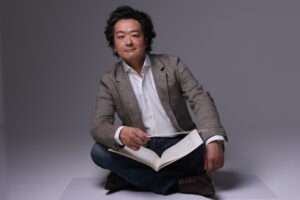
➡Muranaka in Mahler Das Lied von der Erde
➡Muranaka in Ravel “Ma mere l’Oye”
Concerto Sinfonico Omaggio a Debussy al Teatro Bellini di Catania 2018
➡https://www.teatromassimobellini.it/concerto-sinfonico-omaggio-debussy/
【Travolgente Concerto di Capodanno al Massimo Bellini】
Scritto da Piero Maenza
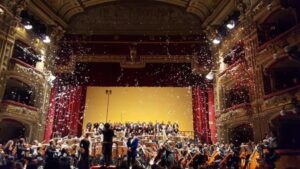
Standing ovation e diversi minuti di applausi al termine del Concerto di Capodanno al teatro massimo Bellini di Catania. Non basta però questa sintesi per dire della partecipazione, del gradimento del programma e dell’esecuzione dell’orchestra diretta dal giapponese Daisuke Muranaka con il coro diretto da Ross Craigmile.
Già dalle prime note dell’ouverture da “Die Fledermaus” (Il pipistrello) di Johann Strauss si respirava l’atmosfera di una grande serata di musica. A confermarlo l’esecuzione di “Gli aranci olezzano” dalla Cavalleria rusticana di Pietro Mascagni, “fuori tempo” ha commentato sorridendo un caro critico alludendo al periodo pasquale in cui è collocata la vicenda rispetto a quello natalizio e di fine anno attuale. Ma l’esecuzione del coro e dell’orchestra è stata tutt’altro che fuori tempo: ci ha immersi nel profumo della Sicilia e dei suoi agrumeti.
E alla natura era ispirato il terzo brano di Johann Strauss jr. “Geschichten aus dem Wienerwald” (Storielle del bosco di Vienna) che ha trasportato il pubblico nella magica capitale austriaca.
Ma il viaggio europeo è continuato con “Les voici! Voici la quadrille!” dalla Carmen di George Bizet, e con “Ainsi que la brise legère”, un valzer di Charles Gounod.
Il ritorno in patria è stato affidato al coro di “Noi siamo zingarelle” da La traviata di Giuseppe Verdi e poco dopo con il sempre emozionante “Va pensiero” dal Nabucco, un cavallo di battaglia dell’ensemble corale diretto da Ross Craigmile, capace di tenere la nota finale sussurrata quasi all’infinito.
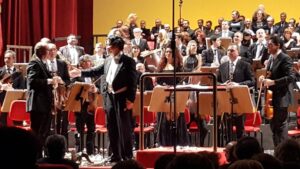
Il direttore Daisuke Muranaka si congratula con il primo violino Vito Imperato
Elegante, poi, la proposta del “Valzer dei fiori” da “Lo schiaccianoci” di Petr Il’ic Cajkovskij. Prefinale viennese con due valzer di Strauss jr. “An der schonen blauen Donau” ( Sul bel Danubio blu) e Kaiser-Walzer (Valzer dell’imperatore).
Gran finale, quindi, in compagnia della frizzante “Vedova allegra” di Franz Lehar con il can-can delle grisettes (“Sì, noi siamo le signorine”) ed il famosissimo, allegro ed ammiccante “E’ scabroso le donne studiar“.
Gli applausi ripetuti ed insistenti hanno “costretto” il direttore Daisuke Muranaka a concedere diversi bis che hanno scatenato e coinvolto il pubblico a far parte dell’esecuzione. Già i titoli dei brani, famosissimi, fanno intendere l’emozione, il senso di insieme che ha permesso di prendere parte senza inibizione all’invito di Muranaka: “Tric trac polka”, “Marcia Radetzsky” ed il Can-can dall’”Orfeo all’inferno” di Jacques Offenbach.
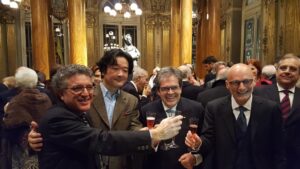
Francesco Nicolosi, Daisuke Muranaka, Enzo Bianco, Roberto Grossi
Si capisce , quindi, la standing ovation al termine dell’esecuzione ed anche la soddisfazione , nella hall, del direttore artistico Francesco Nicolosi, del maestro Daisuke Muranaka, del sindaco Enzo Bianco e del soprintendente Roberto Grossi.
Un concerto, al quale ha assistito anche l’assessore regionale Anthony Barbagallo, che conferma la grande tradizione ed il livello di orchestra e coro del teatro massimo Bellini e l’affetto che i catanesi hanno per questa intoccabile presenza culturale.
➡Muranaka in La Mer of Debussy
Concerto dell’Apertura della Stagione Concertistica Orchestra Sinfonica Siciliana 2019
Concerto Sinfonico 2020 a Teatro Lirico di Cagliari
➡Muranaka in Dvorak Te Deum(2020)
➡Muranaka in Mendelssohn Hebriden Overture(2020)
➡Management Europe(Opera)
A.C. S.r.l. Via Tracia 2 00183 Roma Italia
E-mail: alecatteruccia@tiscali.it
Phone: +39 06 77 202 447
Fax: +39 06 77 202 447
➡Muranaka in Mahler 5th
➡Muranaka in Schoenberg Die Verklärte Nacht
NEXT CONCERT
●Friday 31 March, 2023 MinatoMirai Hall, Yokohama
>Daisuke Muranaka conductor
>Orchester AfiA
>Mahler Symphony No.9
NEXT CONCERT➡Ticket
Mahler Symphony No.9
次回の公演➡チケット予約はこちら!
Friday October, 2018 Kioi Hall, Tokyo
- Daisuke Muranaka conductor
- Orchester AfiA
- Gloria Campaner piano
- Schumann Symphony No.1 “Spring”
- Ravel Piano Concerto
- Schumann Symphony No.3 “Rhein”
Tuesday 22 March, 2016 Cadogan Hall, London
- Daisuke Muranaka conductor
- Alison Balsom trumpet
- Tom Poster piano
- English Chamber Orchestra
Prokofiev Symphony No.1 “Classical”
Shostakovich Concerto No.1 for piano and trumpet
Haydn Trumpet Concerto
Beethoven Symphony No.4
Thursday 18 February, 2016 Kioi Hall, Akasaka, Tokyo
“Frühlingstraum”
- Daisuke Muranaka conductor
- Alena Baeva violin
- Orchester AfiA
Mendelssohn Overture “Fingal’s Cave”(First London version)
S.Barber Violin Concerto
Schubert Symphony No.9 C major “Great”
Friday 11 December, 2015 Kioi Hall , Akasaka, Tokyo
”Finding Silk Road…”
- Daisuke Muranaka conductor
- Tuomas Katajala tenor
- Laura Nykänen alto
- Orchester AfiA
Toru Takemitsu How slow the wind
Ravel Ma mere l’oye , suite
Mahler/Cortese Das Lied von der Erde (Japanese Premiere)
Friday 18 September, 2015 Kioi Hall , Akasaka, Tokyo
“Let’s Dance!”
- Daisuke Muranaka conductor
- Orchester AfiA
Ravel Le Tombeau de Couperin , Suite
Prokofiev Symphony Classique
Beethoven Symphony No.7
Friday 26 June, 2015 Kioi Hall , Akasaka, Tokyo
“The Power of DO”
- Daisuke Muranaka conductor
- Akiko Yamamoto piano
- Orchester AfiA
Beethoven Coriolan Overture C minor Op.62
Mozart Piano Concerto No.25 C major K.503
Schumann Symphony No.2 C major Op.62
May 2015 , the Church of St Mary, Fairford, Gloucestershire UK
”Tragödie”
- Daisuke Muranaka, conductor
- English Chamber Orchestra
- Katya Apekisheva piano
Beethoven Overture “Egmont” Op 84
CHOPIN Piano Concerto No 2 in F minor Op 21
SCHUBERT Symphony No 4 in C minor D417 ‘Tragic’
Wednesday 18 March, 2015 , Cadogan Hall , London UK
”Scotland”
- Daisuke Muranaka , conductor
- English Chamber Orchestra
- Soloist: Gloria Campaner , piano
Beethoven Overture Leonore No.3
Schumann Piano Concerto
Mendelssohn Symphony No.3 “Scotland”
Thursday 2 October, 2014 Kanagawa Kenritsu Ongakudo
”Ballade”
- Daisuke Muranaka, conductor
- Orchester AfiA
- Soloist : Akihiro Miura (Violin)
Schumann Overture
Beethoven Violin Concerto D major
Mendelssohn Symphony No.3 Scotland
Tuesday 3 June , 2014 Kanagawa Kenritsu Ongakudo
”Legend”
- Daisuke Muranaka, conductor
- Orchester AfiA
- Soloist:Irina Mejoueva(Piano)
(Leader: Akihiro Miura Tokyo Philharmonic Orchestra)
Mendelssohn Melusine Overture
Schumann Piano Concerto
Beethoven Symphony No.3 Eroica
Friday 21th February, 2014 Tokyo Hamarikyu Asahi Hall
”Elfentanz”
- Daisuke Muranaka, conductor
- Orchester AfiA
(Leader: Akihiro Miura Tokyo Philharmonic Orchestra)
Mendelssohn Ein Sommernachtstraum (Complete)
Beethoven Symphony No.2 Op.36
Wednesday 2th April, 2014 London Cadgan Hall
“Nature in Romanticism”
- Daisuke Muranaka, conductor
- English Chamber Orchestra
- Caroline Dale, Cello
Beethoven Egmont Overture
Schumann Cello Concerto
Beethoven Symphony No.6 “Pastorale”
Wednesday 6th November, 2013 , London Cadgan Hall
“Natural Poem and Music”
- Daisuke Muranaka, conductor
- English Chamber Orchestra
- Sophie Bevan, soprano
- Alena Baeva, violin
- Yuri Bashmet, viola
Britten Les Illuminations
Mozart Sinfonia Concertante K.354
Arvo Part Cantus in Memorium Benjamin Britten
Schoenberg Verklaerte Nacht
Friday 18th October, 2013 19:00 Tokyo Hamarikyu Asahi Hall
“Mondnacht”
- Conductor: Daisuke Muranaka
- Orchester AfiA (Leader: Roberto Baraldi Grand Teatro Fenice di Venezia)
Mozart Divertiment K.136
Mendelssohn Octet (String Orchestra Version)
Schoenberg the Night of Transfigration
Tuesday 16th July 2013 19:00 Tokyo Hamarikyu Asahi Hall
“ Goethe’s Italian Journey ”
- Conductor: Daisuke Muranaka
- Orchester AfiA
(Leader: Akihiro Miura Tokyo Philharmonic Orchestra)
Mendelssohn The Hebrides Overture
Mozart Symphony No.36 K.425 Linz
Mendelssohn Symphony No.4 Italian
Daisuke Muranaka conducts English Chamber Orchestra(18/03/2015)
Familiar Music Performed with Freshness and Evident Joy
United Kingdom Beethoven, Schumann & Mendelssohn: Gloria Campaner (piano), English Chamber Orchestra/ Daisuke Muranaka (conductor), Cadogan Hall, London 18.3.2015 (CS)
Beethoven: Overture ‘Leonore’ No.3 Op.72b
Schumann: Piano Concerto in A minor Op.54
Mendelssohn: Symphony No. 3 in A minor Op.56 (‘Scottish’)
Although it can be exciting to attend the first performance of a new work or to have the opportunity to experience rarely heard repertoire, it can be just as satisfying to indulge oneself with an evening of ‘familiar classics’; especially if the music is performed with the freshness and evident joy displayed at the Cadogan Hall by the English Chamber Orchestra under the baton of Daisuke Muranaka during this performance of early-nineteenth-century favourites.
Of the four overtures that Beethoven wrote for his opera Leonore (later re-named Fidelio) it is the one which we know as Leonore No.3 (and which was actually the ‘second version’, composed for the 1806 revival of the opera) which has gained most favour in the concert hall. It has a tricky opening which evokes a dark image of Florestan incarcerated in his prison cell. After the punch of the opening chord, the strings and woodwind descend in slow, quiet crotchets: things feel unsettled, forward movement is sporadic and disrupted; there are tentative swells, accents and cautious melodic gestures. Conductor Daisuke Muranaka shaped this tense introduction very effectively, intimating the great drama which is to follow in this quasi-‘symphonic poem’ (which is often performed between the dungeon and public square scenes in the middle of Act II of the opera). Later, Florestan’s memories of brighter, more hopeful times led to playing of stirring Beethovenian vigour without undue heaviness.
The English Chamber Orchestra strings produced a focused sound; the opening of the Allegro was warm and light after the ominous scurrying of the introductory Adagio and if the climatic syncopated passage did not quite come off the first time, then at the recapitulation this episode of dramatic rhythmic argument was tightly directed. The solo off-stage trumpet fanfare (which heralds Florestan’s reprieve) was a striking pronouncement and expressively deployed: slightly guarded at the first declaration, brighter and gleaming with hope when re-stated. Although at times I found the woodwind a little ‘distant’ – perhaps it was a matter of the acoustic or where I was seated in the Hall – the agile duet for bassoon and flute, which comments on the trumpet fanfare, was deftly played, conveying relaxed optimism. In the recapitulation and coda, Muranaka drove the music forcefully forward while retaining sprightly buoyancy, and summoned an appropriately heroic spirit.
The ECO were then joined by Italian pianist Gloria Campaner for an animated and at times flamboyant performance of Schumann’s Piano Concerto in A minor. An extrovert and gregarious performer, Campaner certainly set out to entertain and captivate – and to stamp her own personality on the concerto, though never at the expense of the music’s integrity. Her eyes sparkled and at times she seemed to ‘dance’ through the music, an effect enhanced by the gossamer, mint-coloured ‘cape’ which bloused diaphanously about her, a hazy hue echoing her physical arcs and sways.
Campaner seemed to relish being part of the orchestral sound as much as articulating her own response through the solo effusions; she listened intently, smiling and frowning as the music unfolded its arguments, often leaning towards the body of instrumental players, as in the tender exchanges with the strings at the start of the second movement. There was much strong, muscular piano playing – the blocks of towering chords and tumbling cascades which open the Allegro affettuoso were arresting – but also evidence of a gymnastic flexibility, as in the robust and jubilant Allegro vivace finale. Here, Muranaka and Campaner chose a sensible tempo (Schumann’s metronome indication is dotted minim = 72), avoiding breakneck recklessness, and the ECO impressively negotiated the rhythmic minefield of syncopated cross-tempi and accents.
I felt that the balance between orchestra and soloist in first movement was not always well-adjusted, with the keyboard sometimes overshadowing the accompanying lines. But things were more even in the latter two movements and there was much fine playing from individual principals and sections – the oboe’s first movement melody was lovely, while the bassoon, flute and horn all excelled in the Intermezzo. Campaner proved capable of sweet wistfulness too, imbuing the Intermezzo’s graceful theme with a touching halting quality. Throughout, the pianist’s playing was very fluent and deeply expressive; she seemed to ‘live’ every phrase and gesture – transferring the sound from her swaying body to the piano keys, and the music’s drama was ‘played out’ in the movements of her body and rhapsodic facial expressions. Indeed, so responsive was she to every musical inference that the vivacity of her responses was sometimes a little distracting.
Buzzing with energy and exhilaration, Campaner launched vibrantly into her chosen encore, Prokofiev’s Toccata Op.11, the persistent repetitions and virtuosic leaps of which were utterly absorbing. Campaner seemed entranced by the music’s hypnotic figurations and exhortations. In a recent interview for the online journal Culture for Friends, she is reported as remarking: “If I don’t play music, I get sick, I get fever and stomach ache.” After this thrilling performance, one could quite believe it.
Muranaka sustained the natural zest and charm of the Schumann concerto in the atmospheric but elegant presentation of Mendelssohn’s ‘Scottish’ Symphony which followed the interval. The sombre theme of the Andante con moto had presence and character, divided violas, oboe, clarinets, bassoons and horns blending richly. Sforzandos were punchy and added to the tense air of this introductory section, before the Allegro un poco agitato burst into life with the clarinet and strings’ quiet, dancing theme. Throughout the movement a good balance between nervy tempestuousness and refined calm was struck.
The Vivace non troppo charmed with its lightness and boundless vigour. The strings’ staccato semi-quavers were brisk and precise, while the section’s quiet thematic gestures had delicacy and grace. The clarinet’s principal theme – characterised by a wistful pentatonicism and jaunty Scotch snap –was charismatic and captured a folky insouciance. The scherzo’s quiet, retreating close led naturally into the Adagio which itself flowed persuasively; reflective, but never morose. Strong momentum was provided by the dotted-rhythm, funereal, march-like gestures of the woodwind and brass, while the first violins’ ‘song without words’ unfolded serenely. Perhaps Muranaka might have made more of the thematic contrasts within the final Allegro vivacissimo – a more aggressive bite in the first subject and greater docility in the second would have highlighted the inherent drama. But there was again much fine and sensitive playing here and Muranaka built to a majestic close. Overall, the ECO did not overdo the Romantic angst and produced music which perfectly embodied Mendelssohn himself: urbane and elegant.
Claire Seymour
20/21 May, 2011 (Teatro Politeama ,Palermo/Italy)
Direttore : Daisuke Muranaka
Orchestra: Orchstra Sinfonica Siciliana
Mendelssohn : Ouverture ” Hebriden”
Britten : Four sea interludes from “ Peter Grimes”
Wagner : Ouverture “Der fliegende Hollaender”
Debussy : La mer
Concerto di “mare” per Daisuke Muranaka, al Politeama, con la Sinfonica Siciliana. “Col mare va più d’accordo come artista che come uomo, o come stomaco” avevano constatato gli amici di Mendelssohn dopo il viaggio alle Ebridi. E in realtà l’Ouverture “Le Ebridi” (La grotta di Fingal), in apertura di programma, riuscì a entusiasmare anche Wagner. Il senso dello spazio e la fantasia coloristica rendono con intensità l’incanto di una visione che improvvisamente erompe in tempestose sonorità e che Muranaka ha assecondato con coinvolgente impeto. Strettissimo il filo con l’ouverture wagneriana del Vascello fantasma, con i Quattro interludi marini dal Peter Grimes di Britten e infine con La mer di Debussy. Il gioco dei contrasti negli Interludi, l’addensarsi della tempesta wagneriana, lasciavano affiorare equoree sinuosità ne La mer(dedicata alle vittime dello tsunami)con sottilli gradazioni in un tessuto sonoro mantenuto someeso da Muranaka per esplodere nello “schizzo” conclusivo in tumultuosa grandiosità.(“SPA”)
Vittime dello Tsunami, Sinfonie dell’Aqua
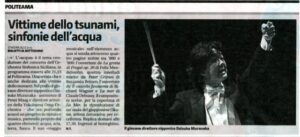
His recent concert on Radio Rai 3 in Italian Broadcasting Corporation on 14 April.
http://www.radio3.rai.it/dl/radio3/concerti/ContentItem-3b2da567-b42d-45f6-8d02-d09a52efd0cc.html
Concerto Euroradio
2010 JAPAN MUSIC COMPETITION
Orchestra Filarmonica della Città di Tokyo
violino Kazuhito Yamane
direttore Daisuke Muranaka
Dmitri Šostakovič
Concerto n.1 per violino e orchestra in la minore op.77 (op.99)
- Nocturne: Moderato 011.09 min.
- Scherzo: Allegro 006.43 min.
- Passacaglia: Andante – Cadenza
- Burlesque: Allegro con brioRegistrato il 23 ottobre 2010 a Tokyo. Takemitsu Memorial, Opera City Concert Hall.
➡村中大祐 関連サイト(Sorry in Japanese)
- 公式サイト(日本語・英語):https://daisukemuranaka.com/
- 日本語ブログ:https://muranaplanet.com/
- 人生最強の音楽教養講座:https://jinseisaikyou.com
- 指揮者村中大祐有料会員サイト:https://clubmuran.com
- ポッドキャスト:https://podcasts.bcast.fm/muranplanet
- You Tube チャンネル:https://www.youtube.com/channel/UC5ofzIFBD0fH95A__M0HFlg
- クラシックCH:https://bit.ly/2Uzo3uY
- 指揮者村中大祐メルマガ: https://clubmuran.com/shop/
- Orchester AfiA:https://afia.info/
- Linktree ➡https://linktr.ee/muranplanet
➡Muranaka in Schubert Great
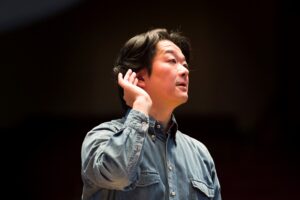
Daisuke Muranaka, conducting English Chamber Orchestra. Cadogan Hall, London, Britain
Photo©
村中大祐(指揮者):Orchester AfiA芸術監督&CEO/イギリス室内管弦楽団国際招聘指揮者
これまで国内メディアには、テレビ朝日系列「題名のない音楽会」、日本テレビ系「深夜の音楽会」、BSフジ「Table of Dreams 夢の食卓」、NHK教育テレビ、NHKBSプレミアム、テレビ神奈川、NHKFM,FMTokyo,FM YOKOHAMAなど出演多数。
第11回出光音楽賞ほか受賞多数。現在Orchester AfiA芸術監督、イギリス室内管弦楽団国際招聘指揮者。これまで英国グラインドボーン音楽祭、スイス、ザンクガレン・オペラ祭、ヴェネツィア・フェニーチェ歌劇場、テアトロ・マッシモ、新国立劇場など世界の主要オペラ座で活躍。活動の拠点をウィーン、ローマ、ロンドン、東京とし、世界中の様々な場所で活躍してきた。6か国語を自在に使い、音楽のみならず、様々なジャンルで自由な表現活動を続けている。
日本国内では、NHK交響楽団をはじめ国内主要オーケストラに客演し、2006年以降は横浜市と共同でオペラカンパニーとオーケストラを設立し、その芸術監督に就任。日本国内の若手音楽家、声楽家を育成して、ヨーロッパの歌劇場へと送り出す人材ポンプを創り上げたことで、横浜市創造都市のイメージアップに尽力した。
2013年よりOrchester AfiAを設立。合同会社AfiAを同時に起業して、会社組織としてのオーケストラ運営のプロトタイプを世界で初めて成功裏に導いた。村中はその間、ロンドンと東京を中心に2011年、「自然と音楽」演奏会シリーズを開始。この活動は世界の注目を集め、2016年、オランダ・ロッテルダムで開かれたクラシック音楽の祭典「Classical:NEXT」のイノヴェーション・アワードのファイナリストにノミネートされ、世界2500団体のプロフェッショナルな音楽団体の中から、そのベスト10に選ばれたことは、記憶に新しい。
また近年ではOrchester AfiAとのレコーディングや、ロンドンのカドガン・ホールにおけるイギリス室内管弦楽団との演奏を中心に活動しているが、中でも英国王室からの招きにより、チャールズ皇太子が村中の指揮を絶賛して、自宅に親書を何度も送り、国際招聘指揮者という称号を与えたことは特筆すべき事件だった。
2013年にはベンジャミン・ブリテンの生誕100周年をロンドンで指揮して絶賛を博した村中は、それに続いてロンドンにおけるベートーヴェン交響曲シリーズを大成功に導いた。
2019年にはイタリアのベッリーニ歌劇場におけるドビュッシーの没後100周年公演に招聘され、交響詩「海」「夜想曲」などを指揮して好評を博した。また、2019年には、イタリア国営の3つのオーケストラの一つ、シチリア交響楽団(Orchestra Sinfonica Siciliana)のシーズン開幕公演を指揮。ソリストにウート・ウーギを迎え、シューマンとブラームスの演奏を熱演して、イタリア国内で大きな注目を浴びた。
村中はOrchester AfiAと、これまでにメンデルスゾーン交響曲3,4,5番の録音をリリースしており、またシューベルト交響曲「グレート」はレコード芸術誌や新聞誌上で特選盤に選ばれている。2020年はシューマンの交響曲全曲録音がリリース予定である。
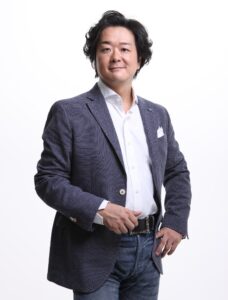
➡Muranaka in Schumann 3rd Symphony
「有名な作品の、新鮮で、喜びに満ち溢れた演奏」
2015年3月18日 英国ロンドン・カドガンホール
指揮:村中大祐 ピアノ:グローリア・カンパナー
演奏:イギリス室内管弦楽団
ベートーヴェン:「レオノーレ」序曲第3番
シューマン:ピアノ協奏曲
メンデルスゾーン:交響曲第3番「スコットランド」
新しい作品の初演や聞きなれないレパートリーを聴く機会があるのは確かにエキサイティングなものかも知れないが、聴き慣れた古典作品の夕べに自らを委ねることができるなら、それは確かに素晴らしく満足の行く体験に違いない。それが音楽的な新鮮さと明確な喜びに満ち溢れた演奏となれば、なおさらのことである。当夜のカドガンホールで行われた村中大祐指揮のイギリス室内管弦楽団による19世紀初頭の作品の演奏は、まさにそういった趣の演奏会であった。
ベートーヴェンは歌劇「レオノーレ」(後に「フィデリオ」と改名しているが)の為に4曲の序曲を作曲しているが、当夜の序曲は「レオノーレ第3番」として知られており、1806年の再演のために作曲された実際には2番目のバージョンである。この曲は演奏会の曲目としてしばしばプログラムに載る作品でもある。
この曲の始まりに仕掛けられた暗澹とした雰囲気は、フロレスタンの地下牢に押し込められている情景を見事に想起させる。冒頭で強奏される和音のパンチが炸裂した後、弦楽器と木管楽器のゆっくりとした四分音符の下降が不安を募らせ、推進しようとする勢いは分断され邪魔されてしまう。そこに生まれようとする波動やアクセント、そしてメロディーライン。指揮者の村中大祐はこういった要素を、冒頭から緊張感を持って人間的ドラマに仕立て上げ、後に続く「交響詩的」な情景へと見事に導いて見せた。(歌劇「フィデリオ」の第二幕の中で地下牢から公衆広場へと続く場面転換に際して、この曲がしばしば挿入されるのは、こうしたドラマ性の所以であろう。)フロレスタンが過去に経験したであろう明るく希望に満ちた時間への追憶が、ベートーヴェンの意図したエキサイティングで雄弁な表現へと、軽い足取りで正に転換されたのを目の当たりにすることができた。
イギリス室内管弦楽団の弦楽パートは実にまとまったサウンドを聴かせていた。アレグロでは温かく軽やかで、不気味な動きの導入部のアダージョとは対照的。天気のように移ろいやすいシンコペーションのパッセージは最初にはその姿を隠していたが、再現部になると再び姿を現し、このドラマティックでリズミカルな論法は見事な指揮で表現された。舞台裏に設置されたソロトランペットのファンファーレは、フロレスタンの開放を宣言するものだが、驚くほどの発音と表現力で魅了した。最初の宣言は少し遠慮がちで、二度目の宣言は喜びにあふれ、希望に満ち溢れた表現がなされた。時折木管楽器のバランスが音響的には少し遠く聴こえがちだったものの、これはおそらくホールの残響上の問題か、筆者の座席の位置の問題だろうと思う。ファゴットとフルートの掛け合いの妙はトランペットのファンファーレを補完して巧みに演奏され、リラックスした楽観主義を曲の解釈にもたらすものだった。再現部とコーダにおける村中の指揮は、音楽の圧倒的な推進力を見事に引き出して、浮揚する喜びに溢れながら英雄的な精神を謳歌するものとなった。
その後イギリス室内管弦楽団はイタリア人ピアニストのグローリア・カンパナーを迎えて、昂揚感と時折燃え上がるようなシューマンのピアノ協奏曲イ短調を演奏した。開放的で人気の演奏家、カンパナーは確かに客の心を掴む魅力にあふれ、正に個性的な協奏曲を演奏してみせたものの、決して音楽の自然な流れを失うことはなかった。彼女の眼は燃えるように輝き、時折音楽を通じて踊っているかの様な彼女の演奏は、淡いミント色のマントをあしらった透明なブラウスによって一際強調され、その霞がかかったような色調にこだまするような彼女の体の線と動きが、踊りをさらなる高みへと導いていった。
カンパナーは終始オーケストラの響きと一体になるようでもありながら、自身の音楽をソリスティックな場面でふんだんに描き出し、オーケストラの演奏に耳を澄まして微笑みながら、音楽の論旨を浮かび上がらせていく。しばしば身体をオーケストラ奏者の側にくねらせると、弦楽器との優しい対話を楽しんでいるかのようで、第二楽章の冒頭は特にその傾向が顕著に表れていた。それより遥かに力強く筋肉質のピアノ奏法を用いて第一楽章の冒頭アレグロ・アフェットゥオーゾに挑んだカンパナーは、和音の塔を築き上げたかと思うと、滝のように流れ落ちる表現で魅了して見せた。そのスポーツ選手のような柔軟さは特筆すべきで、第三楽章の堂々として祝祭的な雰囲気を見事に表現していた。ここで指揮者の村中とカンパナーの取った速度は、シューマンの指示するメトロノーム表示の付点二分音符=72を感じ取ることのできる適切なテンポで始まり、無謀なスピードで窮地に追い込まれるのを避けながら、イギリス室内管弦楽団とリズミカルな表現を極めて印象的に共有し、シンコペーションの変化に飛んだテンポとアクセントを活かし切った演奏となった。
筆者はオーケストラとソリストの音量のバランスについて、第一楽章に於いてはピアノの伴奏音がオーケストラに現れる主旋律より大きく聴こえて、あまり良くなかったと感じたが、楽章が変わって首席奏者の個人技や各セクションが素敵な演奏を始めるにつれ、バランスが良く聴こえるようになった。オーボエ首席の最初のメロディーは見事で、ファゴット、フルート、ホルンが素晴らしいカルテットを演奏してみせた。カンパナーは物悲しく甘い切なさを表現できることをここでも立証してみせたが、間奏曲における慈愛に満ちたテーマを心の琴線に触れるようなクオリティの高さで表現していた。全体を通じてピアニストの表現は極めて流れ良く、深い表現力に裏打ちされたものであったが、彼女はどのフレーズやジェスチャーの中にも命を吹き込み、その体の動きから繰り出される打鍵がひとたび音になると、音楽のドラマがその身体と顔の表情から沸き起こってくるかのようであった。正直申し上げて彼女の身体の動きがあまり全ての音楽的ニュアンスに対応しすぎるため、少々音楽の邪魔になるほどだったのである。
エネルギーと陽気に溢れたカンパナーはアンコールにプロコフィエフのトッカータ作品11を演奏したが、延々と続く繰り返しのパッセージと超絶技巧の跳躍は文字通り見事なものだった。カンパナーは催眠効果によって音楽の化身となったかの様子で、最近のインタヴュー(オンラインジャーナル「Culture and friends」)に「わたしは音楽を演奏できないと、病気になるし、熱が出てお腹が痛くなってしまう」と語っていたことが、このスリリングな演奏を目の当たりにして、なるほどと筆者にも納得できる体験であった。
指揮者の村中大祐はその自然な指揮ぶりと魅力をもってシューマンの協奏曲全体を表現してみせたが、それを休憩後のメンデルスゾーンの「スコットランド」交響曲に於いても持続しながら、雰囲気に満ちた、しかしエレガントな味わいの作品に仕立て上げた。アンダンテ・コン・モートの物悲しいテーマが始まると、そこにはすでにこの曲の性格と表情が見事に表現され、ヴィオラとオーボエ、クラリネットとファゴット、ホルンの豊かなブレンドが美しい。スフォルツァンドのパンチが効いて、この導入部に緊張感をもたらし、対照的にアレグロ・ウン・ポコ・アジタートに入ると、クラリネットと弦楽が静かに舞踏のテーマを語り出して、まるで命が吹き込まれるかのようであった。第一楽章を通じてバランス感覚が極めて良く、荒々しく迫りくる嵐と品格を持った静けさの対比が印象的だった。
ヴィヴァーチェ・ノン・トロッポではその軽やかさと無限のエネルギーに魅了された。弦楽器が奏でる十六分音符のスタッカートは歯ごたえがあり、見事な正確さで演奏されたが、もう一方で静かなテーマの表現はデリケートで慈愛に満ち溢れ魅力的だ。クラリネットの冒頭部のテーマは喜びに満ちたペンタトニックとスコットランド風味のはつらつとした雰囲気だが、カリスマ性と民謡風のぶっきらぼうさが混在する表現だ。このスケルツォ楽章が静かで親密な雰囲気で終わると、ごく自然にアダージョへと移行し、それが極めて説得力のある演奏となった。瞑想的だが決して気難しくならず、力強いシーンでは付点音符が葬送音楽のジェスチャーで木管と金管に現れて、一方で第一ヴァイオリンが「無言歌」を演奏して静かな世界を歌いつづるのだった。恐らく村中は第四楽章アレグロ・ヴィヴァチッシモにおける各主題間のコントラストを、さらに明確に表現するつもりだったのだろう。第一主題は極めて攻撃的であるが、第二主題は甘い歌謡性に満ち、この曲に内包されたドラマを描き切っていた。だが同時に、ここでも村中は極めて洗練され感受性に富んだ演奏を披露して、壮大な終結部へと導いたのである。その全てにおいてイギリス室内管弦楽団のメンバーはロマン主義時代の怒涛のような不安をあおりすぎることなく、メンデルスゾーン自身を完璧に体現するかのような音楽を創り出していた。近代的でエレガントなメンデルスゾーンの姿を、である。
クレアー・セイモア
Claire Seymour
➡Muranaka in action with Mendelssohn Scotland Symphony
CDs
Mendelssohn Symphony No.3 Scotland & Octet for Strings (Orchester AfiA)
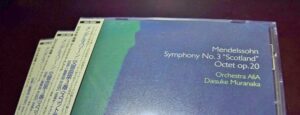
Mendelsshon Symphony No.4 “Italia” & No.5 “Reformation”
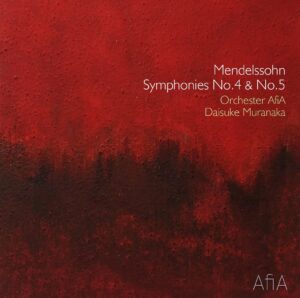
Schubert Symphony No.9(8) Great & Schumann Piano Concerto (Gloria Campaner Piano)
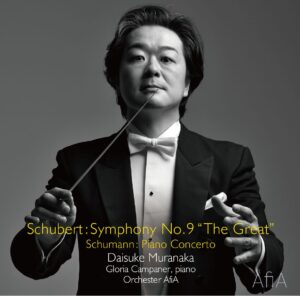
自然と音楽演奏会シリーズについて
「自然と音楽」のコンセプトとは
2011年の東北の大震災がきっかけで誕生いたしました。震災当時私はロンドンにおりましたが、映像から目に入った自然の猛威を前に、人類の無力を痛感いたしました。それから2か月後、わたしは居ても立ってもいられず、イタリアの国営オーケストラと追悼演奏を計画し、「海」をテーマにさまざまな作品を演奏しましたが、舞台上で響き渡る音楽のあまりの美しさに、そこに居合わせた人たちが、私も含め追悼すら忘れて音楽に聴き入り、癒されていた経験が、その後わたしに新たな気づきを与えてくれました。
自然本来の姿を表現するのがベートーヴェン以降の音楽の持つ特性です。有名な「田園交響楽」は自然を音に象った極めて象徴的な作品です。厳密に言えば、もちろん17世紀生まれのヴィヴァルディなどが「四季」といった楽曲を作り上げておりますが、もう少し大きな括りで言うならば、ロマン主義というものが西洋に台頭するようになると、文学や絵画の影響の下、音楽の世界にも風景描写や怪奇的な世界を表現する「ロマンティシズム」というものが生まれてきます。もとは教会音楽のなかで神を賛美する手段だった音楽が、やがて世俗の手に亘り、多くの音楽家の手を経て、ベートーヴェン以降、自然を表現するようになっていくのです。音楽家がそういった「自然を象った」音楽を演奏することがほとんどと言っていい今日、実は音楽を演奏する側が、音楽の持つ本来のメッセージに立ち戻ることは、あまり意識の中になかったと言ってもいいと思うのです。わたしをそこに引きずり戻したのが、ある意味震災の大きなショックでした。
音楽家が自然を表現すること。音楽というメッセージの「矢」が自ずから「放たれる」環境を作ることが、自分のミッションであると思うようになったのです。
なぜ植樹なのか
日本に帰国したある日、テレビでご年配の男性が横浜国大のキャンパスに座って、キャスターと話しているのを偶然見かけました。横浜国大のキャンパスに植樹して、それが10数年たったら立派な⒑数メートルを超す森になっている現実と、語られる言葉の力強さは、私にとって天啓でした。その森に囲まれて座っておられたのは、国際生態学センター長で横浜国立大学名誉教授の宮脇昭先生でした。宮脇先生はこれまで世界中で4000万本を超えるおびただしい数の植樹をされました。これまで鎮守の森を再生する活動や、熱帯地方で不可能とされた植樹事業を成功させ、今では岩手県大槻村で震災がれきを「資源」と捉えて、その瓦礫を森に変え、「いのちの防潮堤」を作っておられます。まるで厄介者だと思われていたものが、木や微生物の働きによって、この世に必要なものに蘇るこのお話。わたしは宮脇先生の語られる植樹を通じて、「負が正になる」瞬間を目の当たりにしました。この素敵なお話は、耳が聴こえなくなる絶望の中、ベートーヴェンが「遺書」までしたため乍ら、ハイリゲンシュタットというウィーン郊外の自然に癒されて行くうちに、交響曲第2番や第3番「英雄」を作曲して見事な精神的復活を遂げるストーリーをわたしに思い出させてくれました。
今回は生きた伝説、宮脇昭先生にご出演を快諾いただき、6月2日(月)に宮脇昭先生の講演会を19時半より横浜開港記念会館で主催いたします。ピアニストのイリーナ・メジューエワ女史にもご協力を頂き、講演会の前にメジューエワ女史のミニコンサートもお楽しみいただけます。
植樹へのご寄附
2014年より「自然と音楽演奏会シリーズ」を通じて、宮脇方式に則った植樹活動に対して、演奏会の収益金よりご寄附を行っております。
「鎮守の森・記憶の森™」
鎮守の森・記憶の森へ
●「鎮守の森・記憶の森」構想について(村中大祐のことば)
森はひとの記憶と繋がっています。森には人々の暮らしの記憶が存在するのです。長い年月に亘り培われた記憶は、自然の奥底に沈殿し、多くのひとの記憶を経て豊かに育ち、それが森となる、というのが、わたしのアーティストとしての森に対する見方です。森の木を伐採し、その樹を使って家を建てることは、昔から行われてきた人間の営みでした。でもその森に住むひとびとは、森のなかに自らの記憶を植え付けてきたのです。そしてその記憶は親から子へと、代々歌い継がれてきました。
わたしは幼いころ、横浜と鎌倉の境を通る「かまくらみち」界隈に住んでおりました。そこには木々が鬱蒼としげる森が、氏神様でもある舞岡八幡宮の御神体として四方に広がり、私ども子供達はそこでカブトムシやクワガタを取り、野鳥を追いかけまわし、時には蜂の巣を攻略してスズメバチに追い回されたりと、腕白三昧の毎日を繰り広げておりました。ザリガニ釣りをして近所の沼から100尾以上の大漁となったこともあります。ですが宅地開発の森林伐採により、その昔私どもが分け入った動物たちの棲家のほとんどが様変わりし、八幡宮の裏山にあたる県立舞岡公園以外、何も残らなかったのです。ただ、その胸に「かまくらみち」と「ぐめうじみち」の道標となる庚申塚を抱きながら、ニ百数十年の間この場所守り続けてきた老木「スダジイ」だけが、道路建築計画の狭間でひっそりと佇んでいます。私たちが子供のときに見た「記憶の風景」を、これからの子供たちが見ることは、もうできなくなってしまったのです。
こういった日本古来の風景を、現在は「里山」という形で呼ぶことが多いようです。こういった日本各地に残っている原風景を見て回ると、必ずと言っていいほどに神社の存在、そして、その社を囲む「鎮守の森」たちに行き当ります。そしてこの「鎮守の森」を、日本人は古くから神社の御神体として崇め奉ったのです。我々の祖先が畏れ敬った「目に見えない」風景を共有することが、その地方に伝わる「祭り」でした。そして先祖代々伝わる「鎮守の森」の「自然」を畏れ、敬い、そして何より「受け継ぐ」ことが、実は日本文化の原風景で
あったような気がするのです。それこそが日本に古くから伝わる「祭り」の意義なのではないでしょうか。
私は1997年から2011年までイタリアのローマを指揮音楽活動のひとつの拠点としておりました。ローマの街と言えば、数あるヨーロッパ諸国の中でも特に遺跡が多いことで知られております。ローマ時代の遺跡は言うに及ばず、ローマから西南にトゥスコラーナ街道を進むと、ローマ人以前のエトルリア人の遺跡が、円形劇場とともにTusculum(トゥスクルム)という形で存在します。そこは海抜約400mの高台にある、森に囲まれた素敵な草原です。この場所を3000年に亘り、世界中の人間が共有してきました。そこを訪れたゲーテは、その素晴らしさを堪能し、後に多くの芸術家や思想家がこの場所を訪れます。マネという絵描きもこの風景に深く感銘を受け、この記憶を絵にしたためた一人です。
音楽はベートーヴェン以降「自然」を表現し続けてきました。音楽という「世界の共通言語」によって、今一度「鎮守の森」に代表される「日本の自然」を皆さんとともに体感し、「自然との共生」について考えたい、というのがこのプロジェクトの大切なコンセプトです。
➡お問い合わせ
合同会社AfiA
〒247-0008 横浜市栄区本郷台4-6-8
Tel : 045-516-6498(月~木13時~17時)
Fax : 045-512-8506
E-mail: mail@afia.info
- Management Worldwide
AfiA LLC.
Tel : 0081-(0)45-516-6498
Fax : 0081-(0)45-512-8506
E-mail: mail@afia.info
合同会社AfiA
☎:045-516-6498(月~木 13時~17時のみ)
fax:045-512-8506(24時間)
メール:mail@afia.info
Copyright © AfiA LLC. 2021, Yokohama, Japan. All rights reserved.
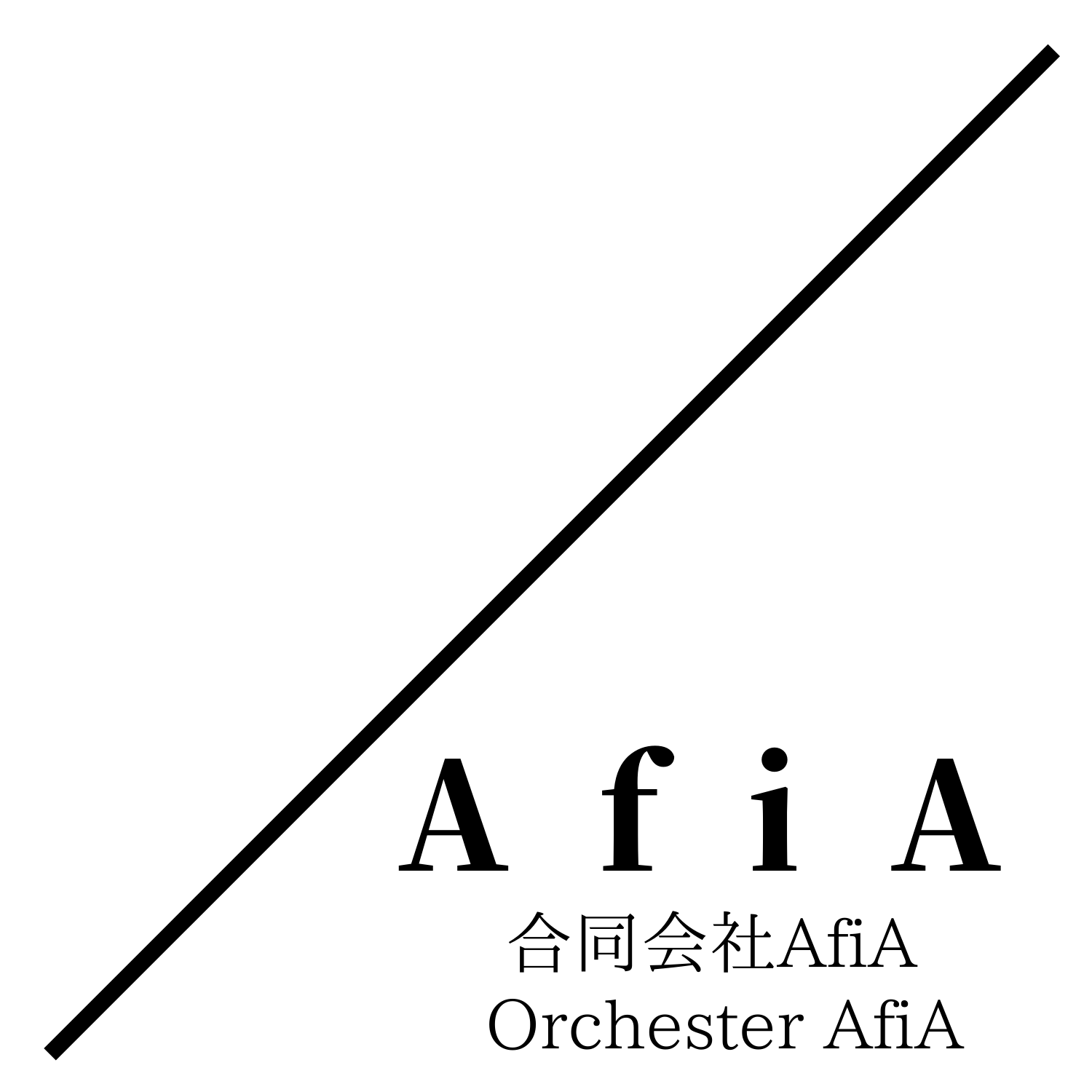
合同会社AfiAは
音楽を通じてホンモノの自由と幸せを探求する人に
人生の不思議を味わい
真実にたどり着くためのお手伝いをしています。
Yokohama, Japan
mail@afia.info
2021 © AfiA LLC.
All Rights Reserved.
➡Muranaka in Wagner Tanhäuser Overture
➡Muranaka in Brahms 2nd Symphony

